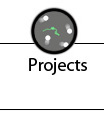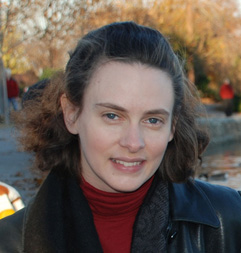







Adriane Seiffert
Principal Investigator
a.seiffert(@)vanderbilt.edu
Curriculum Vitae [ download: PDF, 104kb ]
Interests
My research is directed towards understanding how visual information
that changes over time is assimilated into mental representations that
direct actions. Traditional investigations in psychology have
emphasized the static; for example, how people recognize objects, how
people remember lists, or how people attend to images.
Now is the time to move forward by recognizing that these abilities are
inherently dynamic and exploring the active nature of recognition,
memory and attention. In the PAC lab, we are learning how the
attributes people see shape where they attend, how they look and what
they expect to see later.
__________________________________
Harvard University, Cambridge MA, Ph.D. 2000 Harvard University, Cambridge MA, MA 1998 University of Waterloo, Waterloo ON, B.S. 1995Education
Employment History
Assistant Professor in Psychology, Vanderbilt University, 2004-present
Research Staff in Psychology funded by NIH, Princeton University, 2003-2004
NIH NRSA Fellow with Anne Treisman, Princeton University, 2000-2003
Honors and Awards
Jefferey Nordhaus Award for Excellence in Undergraduate Teaching, awarded by Vanderbilt University, 2009
NRSA Individual Postdoctoral Fellowship awarded by NIH, 2000-2003
Arthur Lehman Merit Fellowship awarded by Harvard University, 1998-1999
National Science Foundation Graduate Fellowship Award, 1995-1998
Publications
Tombu, M. & Seiffert, A. E. (2011). Tracking planets and moons: Mechanisms of object tracking revealed with a new paradigm. Attention, Perception & Psychophysics, in press. doi:10.3758/s13414-010-0060-z.
Thomas, L. & Seiffert, A. E. (2010). Self-motion impairs multiple object tracking. Cognition. doi:10.1016/j.cognition.2010.07.002.
St. Clair, R. L., Huff, M. & Seiffert, A. E. (2010). Conflicting motion information impairs multiple object tracking. Journal of Vision, 10(4), doi: 10.1167/10.4.18.
Fehd, H. M. & Seiffert, A. E. (2010). Looking at the center of the targets helps multiple object tracking. Journal of Vision, 10(4), doi:10.1167/10.4.19
Dewey, J., Seiffert, A. E. & Carr, T. (2009). Taking Credit for Success: The Phenomenology of Control in a Goal-Directed Task. Consciousness & Cognition, doi:10.1016/j.concog.2009.09.007
Ko, P. C. & Seiffert, A. E. (2009). Updating objects in visual short-term memory is feature selective. Memory & Cognition, 37, 909-923, doi:10.3758/MC.37.6.909
Tombu, M. & Seiffert, A. E. (2008). Attentional costs in multiple-object tracking. Cognition, 108(1), 1-25, doi:10.1016/j.cognition.2007.12.014
Fehd, H. M. & Seiffert, A. E. (2008). Eye movements during multiple object tracking: Where do participants look? Cognition, 108(1), 201-209, doi:10.1016/j.cognition.2007.11.008
Sohn, W. Y. & Seiffert, A. E. (2006). Motion aftereffects specific to surface depth order: Beyond binocular disparity. Journal of Vision, 6(2), 119-131, doi:10.1167/6.2.3
Seiffert, A. E., Somers, D., Dale, A., & Tootell, R. (2003). Functional MRI studies of human visual motion perception: Luminance, texture, attention and after-effects. Cerebral Cortex, 13(4), 340-9, Online
Ashida, H., Seiffert, A. E., & Osaka , N. (2001). Inefficient visual search for second-order motion. Journal of Optical Society of America A, 18, 2255-2266, doi:10.1364/JOSAA.18.002255.
Seiffert, A. E., & Cavanagh, P. (1999). Position-based motion perception for color and texture stimuli: Effects of contrast and speed. Vision Research, 39, 4172-4185, doi:10.1016/S0042-6989(99)00129-7
Somers, D., Dale, A., Seiffert, A. E., & Tootell, R. (1999) Functional MRI reveals spatially specific attentional modulation in human primary visual cortex. PNAS, 96(4), 1663-8, Online
Holcombe, A. O., Macknik, S. L., Intriligator, J., Seiffert, A. E., & Tse, P. U. (1999). Wakes and spokes: New motion-induced brightness illusions. Perception, 28, 2131-1242, doi:10.1068/p2965
Seiffert, A. E., & Cavanagh, P. (1998). Position displacement, not velocity, is the cue to motion detection of second-order patterns. Vision Research, 38, 3569-3582, doi:10.1016/S0042-6989(98)00035-2
Milliken, B., Joordens, S., Merikle, P., & Seiffert, A. (1998). Selective attention: A re-evaluation of the implications of negative priming. Psychological Review, 105 (2), 203 - 229, doi: 10.1037/0033-295X.105.2.203
Seiffert, A. E. & Di Lollo, V. (1997). Low-level masking in the attentional blink. Journal of Experimental Psychology: Human Perception and Performance, 23 (4), 1061-1073.
Di Lollo, V., Seiffert, A. E., Burchett, G., Rabeeh, R. & Ruman, T. A. (1997). Phosphor persistence of oscilloscopic displays: A comparison of four phosphors. Spatial Vision, 10 (4), 353-360.
Bischof, W. F., Seiffert, A. E. & Di Lollo, V. (1996). Transient-sustained input to directionally-selective motion mechanisms. Perception, 25, 1263-1280, doi:10.1068/p251263
For published Abstracts, Invited Presentations, Research Grants, and Service, see Curriculum Vitae [PDF].
[ top ] [ People ]